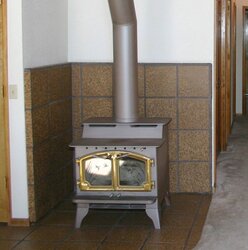Thanks to everyone for the responses and ideas. Here is the impetus for my wanting to install secondary tubes.
1. The results of this baffle are unbelievable! Where an average load of wood used to use 1/4 of the water in my stove stop steamer, I am not going through 1/2 to 3/4 per burn! An overnight burn will leave just enough to cover the bottom! To heck with debating stove top temperatures, those results speak volumes of the efficiency gained through this setup.
2. While I love the added heat gained from my wood, what I am not happy with is my flue gases. I now have smoke

I never did before except for about 10 minutes after a reload. From then on out, it would be nothing but heat waves. Now, I am getting 30mins on an average load to 60-75 minutes on an overnight load of white smoke from the chimney. All the while the stove is producing killer heat and the chimney is about 350 degrees (normal).
While I love the added heat my number one goal is safety. I cleaned the chimney upon adding this baffle so that I can check to see accumulation as a result of its addition.
In the past I get very little build-up in my chimney (a handful after a month of solid burning with this old pre-epa monster). However, my chimney is exterior masonry and the creosote that I did collect would be the second stage variety from the top third of the chimney.
I have discussed the smoking issue with the metal shop buddy who built this for me, and he believes even with the added smoking that I am going to find less 2nd degree creosote in the chimney since I am no longer needing to use my stove damper and the velocity of my flue gasses will have increased.
Even if he is correct, the smoking issue bothers me from a smell standpoint (I like my neighbors) and an environmental standpoint (no tree hugger but I don't like making a bigger impact than necessary).
My thought is that a simple secondary, while it may not be perfect, may add enough extra air in the back of this baffle to help better burn this smoke I am finding.
If I open both doors with a full load it is amazing to see the fire box FULL of flames and the chimney smoke will immediately clear up. If I add more primary air with the doors closed however I will overfire in no time. I am hoping that a small amount of secondary air in the right spot will make the perfect balance.
What do ya's think?
pen



 I never did before except for about 10 minutes after a reload. From then on out, it would be nothing but heat waves. Now, I am getting 30mins on an average load to 60-75 minutes on an overnight load of white smoke from the chimney. All the while the stove is producing killer heat and the chimney is about 350 degrees (normal).
I never did before except for about 10 minutes after a reload. From then on out, it would be nothing but heat waves. Now, I am getting 30mins on an average load to 60-75 minutes on an overnight load of white smoke from the chimney. All the while the stove is producing killer heat and the chimney is about 350 degrees (normal). 